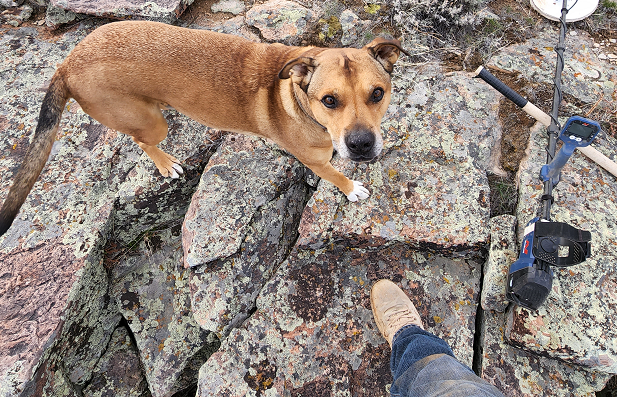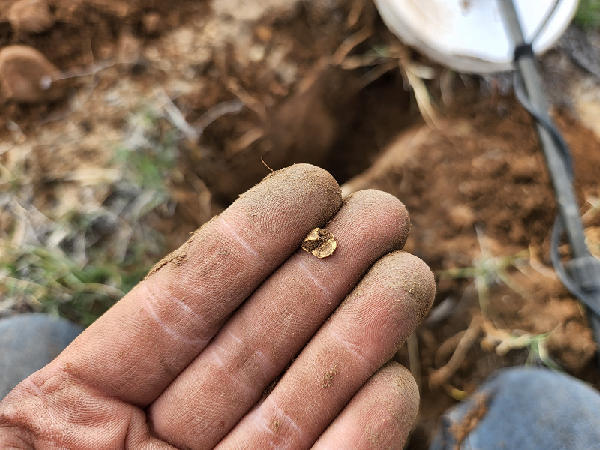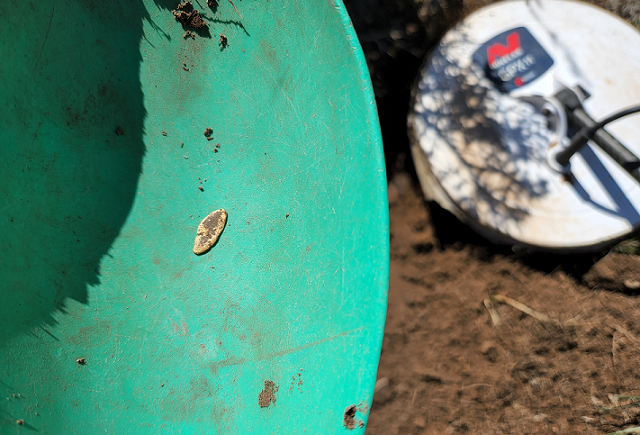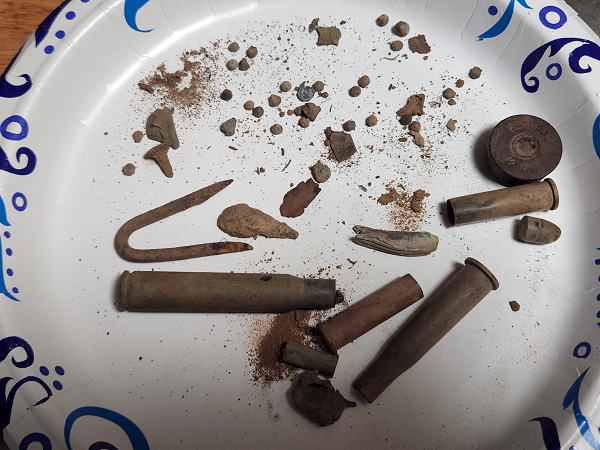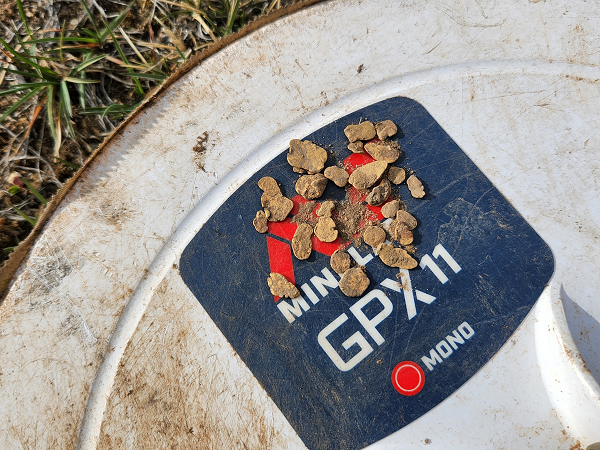-
Posts
2,464 -
Joined
-
Last visited
Content Type
Forums
Detector Prospector Home
Detector Database
Downloads
Everything posted by jasong
-

GPX 6000 And Audio Boosters - What Is Your View?
jasong replied to Northeast's topic in Minelab Metal Detectors
It just occurred to me that the battery seems to be lasting significantly longer while using headphones. I was burning through batteries every 6-7hrs with the speaker and had to keep a spare battery on me at all times since I never had enough juice to finish a day with. Is it my imagination or have I just been detecting shorter days? I guess carrying the headphones or a booster or whatever isn't as bad if I can trade off not having to tote an extra battery with me. For future designs, having a detachable speaker module that turns into like a clip on WM12 type thing would be awesome. You can keep it on the detector for low wind days, or clip to your collar or backpack for high wind days. Just getting the speaker up around head level rather than elbow level and facing backwards makes a world of difference, and wouldn't require a booster IMO, especially if the speaker went up another 1-2 notches higher volume than it does currently. I think the WM12 had way less delay than the 6000 phones, I'm finding the BT delay increasingly offputting. -
Nice. Gotta love seeing cleanups like that still happening in this day and age!
-

Which Frequency Is Running In Each Mode?
jasong replied to vive equinox's topic in Minelab Equinox Forum
What are the specs on the 24" deep silver cache? Like, what sort of container is it in, or how many and what sorts of silver objects are in it? What sort of soil is it buried in? -

GPX 6000 And Audio Boosters - What Is Your View?
jasong replied to Northeast's topic in Minelab Metal Detectors
Another headphone hater here too. People have recommended that Avantree torus setup a good number of times, but I just can't convince myself to have another thing to rig up and keep track of. I can't wear necklaces either, they bother me, and I dont want something around my neck like that. I'm almost considering a booster. Almost. But I cant bring myself to having more extraneous stuff, one of the 6000s strength is quickness and simplicity. What I would consider using is something like the wm12. I'm assuming it's not possible to connect to the 6000 though? Or is it? In my head I think I'd try building one if I found time. But I know I never will get to it in reality. -

Make Gpx 6000 Headphones Quieter In Wind?
jasong replied to jasong's topic in Minelab Metal Detectors
Has any detector manufacturer experimented with tactile feedback in the handle in the other detecting realms like coins, relics, underwater, etc? Sort of like pinpointers have a vibrate mode. Except, going further and making the vibrations scale continuously with signal strength just like the audio does so you can sense variations in the signal and not just an "on/off"? I'm curious if it'd be accurate enough compared to our sense of hearing. Maybe not... But a major strength of the 6000 is simplicity - no extraneous parts and pieces required. I really don't even like having to take these headphones with me and keep track, let alone stuff on top of them. Plus the audio delay in them bothers me more than it probably should. Taking more stuff to deal with the headphones is not appealing to me personally, that's just me though, I'm an oddball. But these are all great ideas that sound like they will help deal with the wind. -

Exploration And Windy Rocky Mtn Nuggets
jasong replied to jasong's topic in Detector Prospector Forum
I think after I'm done exploring and mapping I'll go to one of these spots and work it out with the 6000, gridding. Then go run that 15" concentric over it and see what it pulls up that the 6000 missed, then try the 17" cc over it too. Not scientific by any means, just out of pure curiosity.. My elbow is garbage, so if that 15" cc keeps up with the 17" cc to some degree, then that's the only one I'll be using. I still haven't had a chance to run the 15" yet but its noticeably lighter in my hands. A footnote for others reading this: I don't know if you can even still buy the X Coils in the US due to the geopolitical climate and all. But damn... that 17" cc is a weapon. I'm not exaggerating. It's like having my own personal GPZ 2 in terms of outright depth. I got these right after my last prospecting season ended, and didn't really get a chance to try them until recently, as I was mostly running the 6000 (it's definitely still my main detector though). -

Exploration And Windy Rocky Mtn Nuggets
jasong replied to jasong's topic in Detector Prospector Forum
Not a dumb question at all, I'm not 100% sure actually. The easiest answer is that this gold was initially derived from glaciation carving into ore bodies and flattened out during this process. Except I can't find any evidence of glaciation. Which doesn't mean it didn't happen, it could just all be erased now. Most of the high Rockies were glaciated at various points in time. I see evidence nearby, but at best what I can find here are potential fossil meltwater channels. I don't think glaciers are the whole story though. I have a pretty wacky theory actually. I think these nuggets aren't coming from any kind of modern gravels, but instead from the bottom member of a ~500ft thick sedimentary formation. My theory is that some of this flatness is simply from getting squished by the enormous mass of rock and sediment sitting on top of them. I have one the size of my fingernail that only weighs 0.1 grams. The flatness/thinness is pretty remarkable, and that factor also seems to indicate to me that it wasn't glaciers alone, something else happened. Also, they aren't just flat, under a microscope they are pockmarked with craters, like the surface of the moon. And in many craters, you can see grains of quartz. It's like someone took a hydraulic press and just smashed them and any quartz that was in them cratered the flakes out. -

Make Gpx 6000 Headphones Quieter In Wind?
jasong replied to jasong's topic in Minelab Metal Detectors
Are the stock headphones APTX LL or just APTX? Because I can notice a definite delay with the stock headphones. -

Make Gpx 6000 Headphones Quieter In Wind?
jasong replied to jasong's topic in Minelab Metal Detectors
Hmm both good ideas. I actually have a baseball cap style ushanka hat, just tried it when I saw this, an it won't really fit over the headphones, but that one you linked looks like it would. A hoodie definitely would work, I'll try that next time. It's pretty dang cold out with the wind right now so not a problem until July or so. -
I've been scatter shot prospecting in the Rockies on my ATV, 20-40 mph winds constant. Normally 50 degree is my ideal prospecting temperature, but in winds like this it can be uncomfortable. It's a struggle to hear signals even in headphones in this kind of wind, but doable. There is very little written mining history, and not much geologic mapping and reports available in this area. This is one of long list of places closer to home which I've spent over a decade researching and compiling information on, to explore during free times like this when work and health aren't preventing me from going to the field and it's too hot to prospect down south. In most cases, my coil is the first to touch the ground here, so where there is gold around, it's almost all very easy targets. The ground is pretty mild here too for the most part, just how I like it. Auto+, easy sailing. Locate gold bearing areas, move on to the next. Quick, tactical prospecting...bring the 15" concentric X Coil on the GPZ in later when I want to find the deeper (and conceivably larger) pieces in the deeper soil. This is the type of prospecting and exploration I truly love. And finally I have a machine in the 6000 that makes it easy - no rig up/rig down time. I can drive my ATV until I see good topography and gravels, be detecting in 15 seconds, then throw the detector back on the rifle rack and be moving on within seconds again, until I see somewhere else favorable looking and do it over. My dog thinks I am reaching for beef jerky whenever I set my detector down. He wasn't too happy to see a camera instead. I got him in 2012 and he has been on every single detecting and dredging trip I've ever taken since then. If he can't go, I don't go. Meanwhile, I've yet to convince any of my non-prospector friends to come out with me even once! Some of these cracks in the bedrock hide nuggets. But sometimes they are just hanging out in the grass roots, or in the soil right near surface too. 25 for the day (one is hiding, mostly covered by the wide boy). I like when things work out with nice numbers, so I chose to stop at a pleasing place. I also think this is the most nuggets I've found in one day, so it's easy to remember. There are many more left, but the gold isn't as important as showing an spot is gold bearing in general to me. I found a few patterns. Have a few theories. My understanding of the area is increasing. Have a bunch more spots to investigate and then I can start searching for the lode sources. A trash shot for Simon so he doesn't feel alone in digging the bird shot. Definitely a few more trash targets than nuggets, but was close to 1-1. Can't complain there. On the subject of trash targets, one thing I would like to see improved on the 6000 or whatever it's successor is, is a faster recovery time. I'm finding it quite difficult to use in trash, especially shallow trash, due to how hard it hits, and then stays "hitting" long after the coil has moved away. In places with lots of shotgun pellets or tinslaw bits, this can make it quite difficult to try to work through the trashy spots. And separately, while I mentioned it in another thread, I really do feel like there is some "bogging" down happening in the electronics at random times that is causing me to not just miss targets in my scoop, but in the ground too. Unless it really just is so directionally sensitive that being off on a swing by a few degrees is the difference between hearing a target and not. Anyways, no product is perfect, and I'm glad to finally have a lightweight, quick machine to use with almost no rig up/rig down time. I got close to having this with the GPZ and 8" X Coil, which thankfully showed up at the perfect time to save my elbow from further damage and I'm very thankful for, but the 6000 just is one level quicker still and requires less "stuff" to tote around, so it's my main machine. I do feel the 8" X Coil does better in heavy salt still though, and the 15"/17" concentrics blow the 6000 out of the water when it comes to depth, bar none. I'd sell my GPZ and just stick with the 6000 if it wasn't for those two coils.
-

Make Gpx 6000 Headphones Quieter In Wind?
jasong replied to jasong's topic in Minelab Metal Detectors
They sound really hollow inside, so I was almost considering drilling a hole in plastic and injecting some spray foam inside. But it seems like the wind noise is getting through the foam cushioning too which I can't do much about, so I didn't want to potentially destroy a set of headphones for no improvement. I spaced out on all the earlier headphone discussion since I didn't plan on using them. Am I able to basically get any set of AptX headphones to work on the 6000 if I wanted to get some better ones? -
Anyone figured out a good way to make the headphones more insulated to wind noises? I just used them for the first time (I've been toughing it out with the speaker until now, I hate headphones), winds 30-40mph, and it almost wasn't much better than just using the speaker, I could still barely hear the detector through the headphones. It's like they need some earmuffs to go over them to dampen the wind or something.
-
Soil deflation mostly. Happens in places with a lot of wind, the lighter soils blow away over time while the heavier bits remain. Some places wind can be so bad and constant that it will blow the gold around too, and in these case you end up finding nuggets in the grass roots where isolated clumps have grown, right at surface because roots are the only things that hold tight and don't move in that kind of wind.
-

Did This Have An Effect On Idaho Gold?
jasong replied to mn90403's topic in Detector Prospector Forum
Nick Zentner has a lot of good videos on these floods. They've dated them using ash layers and glacial erratics. Much of this water exitted through the Columbia River gorge but there was also another massive flood through Hells Canyon on the Snake River from ancient Lake Bonneville. There are some new theories that it wasn't just ice dams breaking at glacial lakes Missoula and Columbia, but a massive meteorite hitting the ice field around Prince George. On that subject, there is a new theory about a massive meteorite hitting Michigan ice sheets and ejecting a massive cloud of ice projectiles into low Earth orbit. These rained down onto the continent and may have been the reason for the megafauna extinction such as mammoths and giant ground sloths, as well as potentially some pre Clovis human cultures. The ejecta may be responsible for "Carolina Bays" across half the US, recently revealed by LIDAR. -
Nice work! That 8" is a great little coil. Good to see it's keeping up with the 6000. I personally feel like the sensitivity edge just barely goes to the 6000, but it sure is close. I think the 8" does better overall in really salty ground than the 6000 does though - but with the new smaller 6000 coils this balance should shift as the small coils always do better in salt than bigger ones. I really hope that the X Coils are compatible with whatever the next GPZ iteration will be. I suspect ML might find a way to redesign things to make that impossible though.
-

Who Has Had Issues With Their Gpx 6000?
jasong replied to Goldseeker5000's topic in Detector Prospector Forum
Could be that too, I'm unsure. I never had any problem with my 4500 tracking out targets in my soils though, in fact I tried to make a video on it a long time ago and nothing I tried could make it track an actual nugget out, but it was just in mild to medium soils, I rarely find myself in hot ground. My coil control definitely isn't as rigid as some other people here. But that it happens when my coil is flat on the ground when I'm recovering a target in a scoop, and also while swinging/pinpointing, makes me think that isn't the case. I have a pretty well worn scratch pattern on my coil from my scoop recovery that shows I'm running pretty close to the shaft, directly across both the back and front of the coil, not along the side of it. I ran flat wound coils exclusively on both the GPX and GPZ after they became available (aside from the concentric), but I definitely didn't miss anywhere close to the number of targets on those. So I'm leaning towards not just a flatwound issue, but I have no idea. I'm not too sure if it's one thing or a combination of things up to an including operator error at this point. But I definitely do know I've tossed out and/or missed more targets in 6 months with the 6000 than I did my entire detecting career with the 4500 and 7000 so I figured it was worth putting out there. -

Who Has Had Issues With Their Gpx 6000?
jasong replied to Goldseeker5000's topic in Detector Prospector Forum
I guess the larger concern I had wasn't so much losing the targets in the scoop and tossing them, but the fact that I noticed I was losing targets in ground too. And not just faint or tiny ones, some really obvious targets were just not there at all the first pass. They weren't targets I would miss normally for the most part, and it has now made me wonder how often that happened in ground I didn't redetect. If it's a coil dead zone thing, it might mean a lot more overlap is required than I was thinking, which slows things down. If it's a CPU glitching thing, then it requires slowing down and/or more overlap to cover things twice in case of glitch. In any event, while it doesn't appear to be a manufacturing defect, it is a potential issue with a machine that really is designed to be faster and easier to use than the GPZ in my eyes, and thus potentially something the engineers (or newest round of 3rd party coil manufacturers) might be interested in improving upon if possible. -

Who Has Had Issues With Their Gpx 6000?
jasong replied to Goldseeker5000's topic in Detector Prospector Forum
That definitely could be it, or part of it. I've noticed more dead zone on this coil than an older GPX mono too. I think when the weather warms up I'll try doing some coil testing to try to understand this coil a bit more and how it acts at depth and with different target sizes. -

Who Has Had Issues With Their Gpx 6000?
jasong replied to Goldseeker5000's topic in Detector Prospector Forum
I hesitate to post this because I know it'll mostly be written off as bad detecting practice, especially since no one else has seemed to have this issue. But I feel there is something randomly happening with my 6000. Now that I've used it quite lot, I've noticed that the CPU seems to be getting bogged down occasionally, like it's running too much at once with Geosense. I run in Auto+ mostly, the setting where I'd guess the most CPU intensive load is occuring due to ground/EMI/audio processing in the background plus the target processing. The reason I noticed it is because I'm tossing a crazy number of targets out of my scoop. I can't even count how many times I've run my scoop twice over the front and back of the coil, had no target sound at all, and then tossed the scoop. Just to find no target in my hand either. I can only recall this happening a small handful of times with my 4500 or 7000 during the many years I ran them, but I'd estimate I've done it easily 20 or 30 times with the 6000 already. Further, it doesn't just happen with small nuggets like on the 4500/7000, but with bigger stuff too. It also happens during pinpointing far, far more often than on previous machines. Something I wonder if might be happening in cases like Brogansown's post discussing halo effect. And again, not just with tiny targets where it might be expected to lose a target because I thought it was on the front winding but really was on the back winding. Sometimes it'll sound off, but then disappear on the back swipe over the coil. And then not be there for a few iterations, then show back up again. I'm positive the dirt/target isn't moving or shifting in my scoop. It's the machine itself "hiccuping" is what it feels like to me. I'm pretty sure it has to do with speed. As it almost never happens when I run the scoop slowly. It's totally random though, same speed and same target will be heard one time and then not another. I thought it might just be a problem with my 6000, but a friend noticed the tossing targets from his scoop thing as well. I redetected some spots and sure enough I had some screaming targets left right in my footprints and by dig holes. Sure, I could have missed them originally, but that many targets and that loud, very unlikely in my mind. When I redetected my spots with the 4500/7000, I'd very rarely to never leave any screamer or glaringly obvious targets, mostly just faint ones or the type that sound better in one direction than the other. Not the case with the 6000. The 6000's main strength to me is as a "fast" prospecting exploration machine. So, swinging faster than if I was gridding is a necessity to me, it's a big reason I bought the 6000. -
I don't know about hard rock lithium ores like spodumene being detectable, I'd guess no. But in dried lake/sea beds lithium is very small in concentration compared to the other salts, mostly sodium based. I'm not sure there are any economic cases where sodium salts aren't the dominant soil component, so it'd be impossible to tell wether you had sodium or lithium salt with a metal detector. Just that you found some conductive salts, which you can tell even cheaper by just tasting the soil or looking it usually (ex: alkalis). I tried building a photospectrometer to do flame tests for lithium in NV lake beds a while back in order to differentiate sodium from lithium, and as a way to prospect for it. Even that was mostly impossible because the sodium spectral lines are so strong they blow out the lithium, so again it was impossible to differentiate the two. Unfortunately the only good way I know of to prospect for lithium is sending assays in (or buying an atomic absoprtion or other spectrometer, XRF won't detect lithium) and waiting a month for results to come back. Do that and watch some large company come in and just blanket stake everything under you while you wait for assay results, wether there is actually lithium there or not, and you realize lithium prospecting is mostly in the domain of larger companies that can afford to file hundreds or thousands of claims on nothing except pure speculation, and without knowing if there is actually any economic concentrations of lithium there or not.
-
There used to be coyote trappers or hunters towards the west end of Gold Basin that has poison traps hidden. Met them one day and they told me to not take my dog with me in that area. Not sure if they are still out there these days, but just a heads up. A family where I live lost both their dogs to coyote bait a few years back, it was a big debate because the trappers set the baits literally right by a residential area, and the state permitted it. The trappers won and still set bait there, so any dog that jumps a fence is basically dead.
-
My friend just had to send his 11" 6000 coil in due to extreme touch sensitivity developing. On my last trip out I too started to notice it happening to my 11" too, but not so bad I can't use it. Not sure if outlier cases or what, haven't seen any other people post about it happening to them.
-
The real gems of knowledge for me haven't been online mostly, but has been in discovering old papers, notes, maps, and publications that aren't available online and that few to no one else has read today. I have a lot of fun searching for and tracking down these sorts of little known to unpublished papers, same as I like searching for gold. It's prospecting for knowledge in a way, when I can't be out in the field.
-

GPX 6000 Halo Effect On Small Nuggets
jasong replied to brogansown's topic in Minelab Metal Detectors
I think we all agree minerals can leach into the adjacent soils. But I think there is a problem drawing correlaries between hot ground being detectable, and nugget halos being detectable. The source of the clays and alkalis we can detect are derived from massive occurences - great freshwater lakes (NNV), or massive weathering of ore bodies or iron-rich sediments which contained undetectable (with a PI) levels of salts, Fe, etc. We aren't detecting leached halos when we detect a big clay ball or an alkali pocket, it's important distinction. These macro-scale occurences are concentrated down into things like veneers of salt impregnated soils or iron+salt bearing clay pockets as the water evaporates or the ore bodies erode. It's the opposite of leaching on a nugget. They are concentrated down to the scale of feet instead of miles. The source of the halos we are talking about detecting are coming from nuggets on the scale of matchheads - and only derived from the very thin surface layer of these matchheads at that, since the oxidation only occurs on the surface of the nugget. Concentration and scale are key here to the mystery, I believe. I couldn't have detected these NNV soils if the lake hadn't evaporated and concentrated a massive volume of diffuse salts into a thin veneer. Also my PI's usually never hear the massive ore bodies (like swarms of quartz hosted gold/copper/Fe minerals) from which the hot ground I detect is derived from, I can only hear the ground itself because a massive ore body has eroded and concentrated Fe oxides into a thinner layer or pockets of alluvium. I can hear hot rocks though - like magnetites, serpentines, basalts, etc. But again, the Fe in these has been concentrated relative to the rocks/minerals around them due to various geologic processes involving input of energy. To make a similar comparison you would need something like a massive patch of gold nuggets which has somehow leached all their surface Ag/Cu into the halo of one single nugget in the patch. If that was occurring, I could see the argument (there are actually theories of nuggets forming from diffuse fine gold particles like this, due to bacteria). There is really no concentrating force acting on a buried desert nugget halo though. And ones in active water courses are being moved and the halo constantly dispersed. So after the surface Ag/Cu leaches from the nugget, the halo should only get more diffuse over time, this is entropy. There has to be energy applied (like the sun evaporating the surface of a lake, for example) to make it work in reverse. But that's the opposite of what people state, where apparantly the halo effect gets more detectable over time. That's another reason I don't see it being real.


